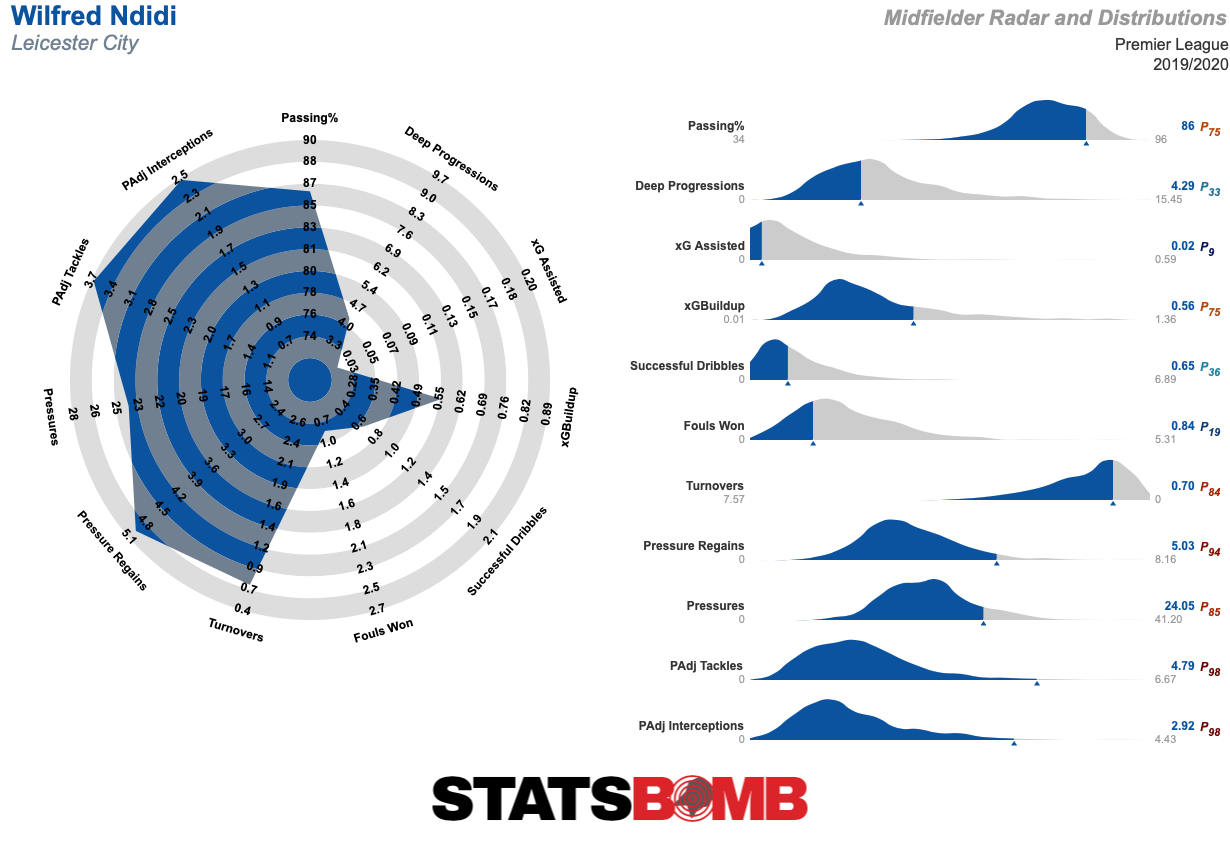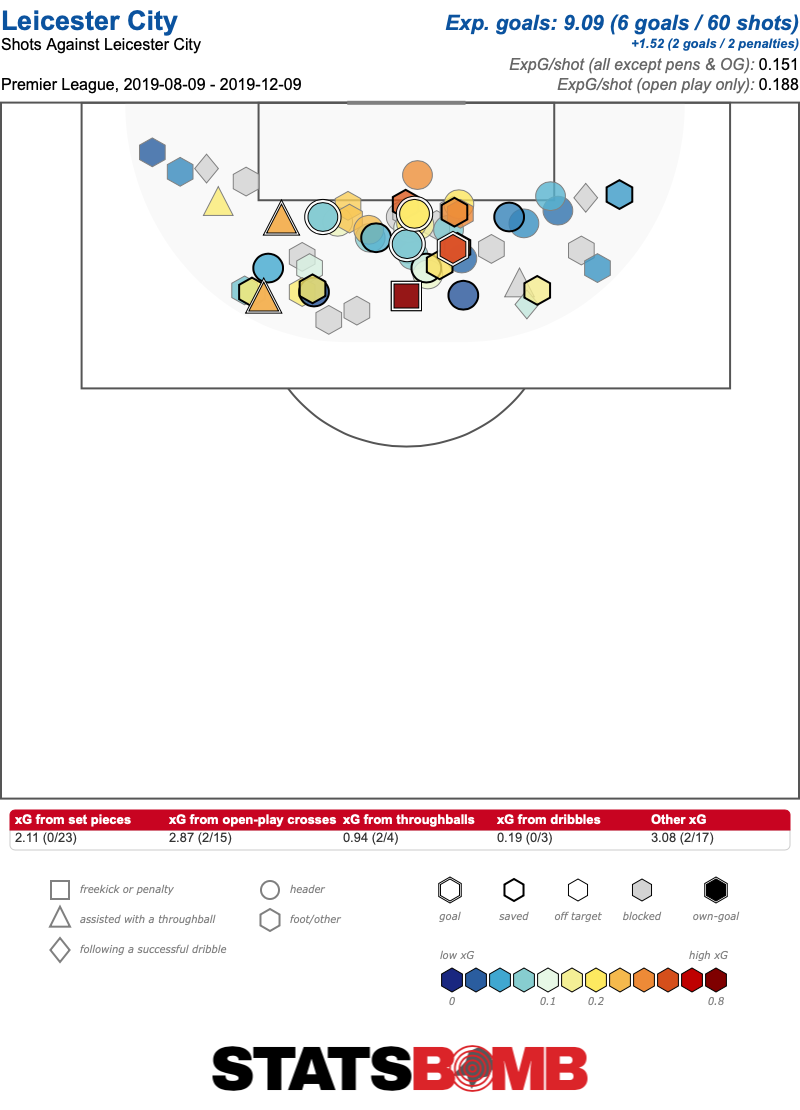After a scintillating start to the season Leicester City have hit a rough patch in the race for the top four. And as results have worsened, so have the team's metrics. Back in August, when some felt Leicester might rip apart the top six, nobody could have imagined it would be this easy. Even Wolves and Sheffield United have kept up with Manchester United and Tottenham, while keeping Arsenal in the rearview mirror, and Leicester have long set their sights higher than just stalking the Champions League spots. Earlier, a spot in the top four did seem to be almost a formality. But that is no longer the case. Having started out with draws against Wolves and Chelsea, Leicester went on a run of 12 wins in 14 league games to storm into second place. By the second week of December, their only defeats had been at Manchester United (1–0) and Liverpool (2–1). They were on a run of eight wins in a row. They had shipped 10 goals, the fewest in the division. The Foxes were 14 points clear of United in fifth. Anyone who kept half an eye on the stats knew Leicester were exceeding the metrics, but had no idea when they would begin to slow down, or, when they did, how badly would they struggle. But the Great Leicester Run stopped on 14 December with a 1–1 draw at home to Norwich, and the team now have just three wins in nine. Their efficiency and their underlying metrics have both declined. During the first 16 games Leicester had a goal difference of 1.81 per game with an expected goal difference of 0.81. To exceed that metric by a goal per game over such a long period is unusual. Since then they have had a goal difference of -0.11 with an xG difference of -0.24. Even in hard times, Leicester have managed to outperform their metrics. Yet the falloff spells trouble.  Any analysis of why Leicester are wobbling must begin with Jamie Vardy. The striker had a hot streak in autumn, scoring 13 goals from an xG of 8.48 (penalties excluded). That kind of efficiency is hard to maintain for anyone not named Lionel Messi (and usually for people named Lionel Messi, too), and Vardy has since lost his sharpness, scoring once from an xG of 1.50. Just in case anyone doubted whether his fortunes really had changed, Vardy missed a penalty at Burnley just before the Clarets struck the winner. And Vardy is not only missing chances, he's getting fewer of them.
Any analysis of why Leicester are wobbling must begin with Jamie Vardy. The striker had a hot streak in autumn, scoring 13 goals from an xG of 8.48 (penalties excluded). That kind of efficiency is hard to maintain for anyone not named Lionel Messi (and usually for people named Lionel Messi, too), and Vardy has since lost his sharpness, scoring once from an xG of 1.50. Just in case anyone doubted whether his fortunes really had changed, Vardy missed a penalty at Burnley just before the Clarets struck the winner. And Vardy is not only missing chances, he's getting fewer of them.  The same goes for Leicester as a team. While they produced few big chances in their first games, they did face strong teams during that spell and still managed to exceed their metrics. When the schedule got easier, they took off. Since then two things have happened. First, they've stopped playing way ahead of their xG.
The same goes for Leicester as a team. While they produced few big chances in their first games, they did face strong teams during that spell and still managed to exceed their metrics. When the schedule got easier, they took off. Since then two things have happened. First, they've stopped playing way ahead of their xG.  Second, the underlying metrics have themselves nosedived.
Second, the underlying metrics have themselves nosedived.  What happened? Given what we know about Vardy, it feels natural to begin this exploration by examining the attack. Brendan Rodgers made only minor changes to his set-up, benching the odd out-of-form player and alternating between a 4-3-3 and 4-4-2 diamond. They've had no major injuries; while Vardy has missed two games, Leicester have won them both. Neither personnel nor tactics offer any clear answer as to why the attack has worsened in almost every aspect.
What happened? Given what we know about Vardy, it feels natural to begin this exploration by examining the attack. Brendan Rodgers made only minor changes to his set-up, benching the odd out-of-form player and alternating between a 4-3-3 and 4-4-2 diamond. They've had no major injuries; while Vardy has missed two games, Leicester have won them both. Neither personnel nor tactics offer any clear answer as to why the attack has worsened in almost every aspect.  The standout metric here is the shots after counter-attacks. You would think teams would've have wised up to Vardy’s runs in behind the defence. Yet in a spell where Leicester spends less time in the lead, it would make sense if opponents defend deeper to protect their leads. In any case, the attack is not been the biggest problem for Leicester. Before the Norwich draw they had conceded two goals in seven league games. They've now shipped 16 goals in 9 games. And as for the defensive metrics, well…
The standout metric here is the shots after counter-attacks. You would think teams would've have wised up to Vardy’s runs in behind the defence. Yet in a spell where Leicester spends less time in the lead, it would make sense if opponents defend deeper to protect their leads. In any case, the attack is not been the biggest problem for Leicester. Before the Norwich draw they had conceded two goals in seven league games. They've now shipped 16 goals in 9 games. And as for the defensive metrics, well…  Where to start? The fixtures offer some consolation: during this spell Leicester have played City at the Etihad, plus Liverpool, Chelsea and a galvanised Southampton. Yet two matches against West Ham and a rout of 10-man Newcastle should have provided some balance. There have been no significant injuries in defence, although midfielder Wilfred Ndidi was sidelined in January due to a knee operation and has started none of the last five league games. His absence has surely played a part, given his defensive output.
Where to start? The fixtures offer some consolation: during this spell Leicester have played City at the Etihad, plus Liverpool, Chelsea and a galvanised Southampton. Yet two matches against West Ham and a rout of 10-man Newcastle should have provided some balance. There have been no significant injuries in defence, although midfielder Wilfred Ndidi was sidelined in January due to a knee operation and has started none of the last five league games. His absence has surely played a part, given his defensive output.  Still, a collective decline of this scale cannot be down to one player. Going back to the radar of horror, two metrics have declined more than others. One is set-piece xG conceded, which has jumped from 0.17 to 0.38 per game. Leicester have conceded four set-piece goals in their last nine games, based on an xG of 3.64 and 27 shots. Not good. The other metric is xG per shot conceded, which has increased from 0.09 to 0.13. If we look at the shots Leicester allowed from close range during their golden autumn, hardly any took place inside the six-yard box. Such was their aerial dominance and ability to stop crosses that they did not have to block a single shot inside this area.
Still, a collective decline of this scale cannot be down to one player. Going back to the radar of horror, two metrics have declined more than others. One is set-piece xG conceded, which has jumped from 0.17 to 0.38 per game. Leicester have conceded four set-piece goals in their last nine games, based on an xG of 3.64 and 27 shots. Not good. The other metric is xG per shot conceded, which has increased from 0.09 to 0.13. If we look at the shots Leicester allowed from close range during their golden autumn, hardly any took place inside the six-yard box. Such was their aerial dominance and ability to stop crosses that they did not have to block a single shot inside this area.  Since then, however, Leicester have given up a slew of shots from within six yards.
Since then, however, Leicester have given up a slew of shots from within six yards.  Time will tell whether Leicester will halt this wobbly spell. In any case, it looks unlikely to derail their season given they're 10 points clear of fifth place. After upcoming games against Wolves and City, they have four matches they're expected to win. None of their top-four rivals are showing signs of putting together a decent run, and should one of them suddenly get it together, Chelsea would surely be the first team to get caught. Rodgers will surely be thankful that, in this particular season, stable form is not the norm but the exception.
Time will tell whether Leicester will halt this wobbly spell. In any case, it looks unlikely to derail their season given they're 10 points clear of fifth place. After upcoming games against Wolves and City, they have four matches they're expected to win. None of their top-four rivals are showing signs of putting together a decent run, and should one of them suddenly get it together, Chelsea would surely be the first team to get caught. Rodgers will surely be thankful that, in this particular season, stable form is not the norm but the exception.
2020
Are the Foxes at risk of getting caught?
By admin
|
February 14, 2020